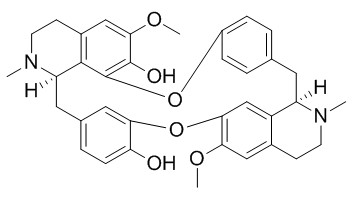(-)-Curine
(-)-Curine can inhibit viability of hepatocellular carcinoma cells in regardless of p53 status.
Inquire / Order:
manager@chemfaces.com
Technical Inquiries:
service@chemfaces.com
Tel:
+86-27-84237783
Fax:
+86-27-84254680
Address:
1 Building, No. 83, CheCheng Rd., Wuhan Economic and Technological Development Zone, Wuhan, Hubei 430056, PRC
Providing storage is as stated on the product vial and the vial is kept tightly sealed, the product can be stored for up to
24 months(2-8C).
Wherever possible, you should prepare and use solutions on the same day. However, if you need to make up stock solutions in advance, we recommend that you store the solution as aliquots in tightly sealed vials at -20C. Generally, these will be useable for up to two weeks. Before use, and prior to opening the vial we recommend that you allow your product to equilibrate to room temperature for at least 1 hour.
Need more advice on solubility, usage and handling? Please email to: service@chemfaces.com
The packaging of the product may have turned upside down during transportation, resulting in the natural compounds adhering to the neck or cap of the vial. take the vial out of its packaging and gently shake to let the compounds fall to the bottom of the vial. for liquid products, centrifuge at 200-500 RPM to gather the liquid at the bottom of the vial. try to avoid loss or contamination during handling.
Nutrients.2020, 12(11):3448.
Natural Product Communications2022, 7(3):1-7.
Applied Biological Chemistry2023, 66:8
Invest New Drugs.2017, 35(2):166-179
Bioorg Chem.2024, 145:107184.
Biomolecules.2022, 12(12):1754.
Front Plant Sci.2020, 11:630.
J Pharm Biomed Anal.2022, 207:114398.
Biorxiv2019, 10.1101
Journal of Third Military Medical University2018, 40(12):1073-1078
Related and Featured Products
Biomed Pharmacother. 2017 May;89:894-901.
(-)-Curine induces cell cycle arrest and cell death in hepatocellular carcinoma cells in a p53-independent way.[Pubmed:
28292017 ]
Hepatocellular carcinoma(HCC) is one of the most common malignancies worldwide, however, drug resistance is still a tough problem of it.
METHODS AND RESULTS:
As in many other cancers, p53 mutations are commonly observed in HCCs (Hussain et al., 2007; Levine et al., 1994) [1,2]. Tumor tissues with mutant p53 seems to be more aggressive and resist to chemotherapy than that harboring wide-type p53 (Harris and Hollstein, 1994; Parrales and Iwakuma, 2015) [3,4]. (-)-Curine, a novel bisbenzylisoquinoline alkaloid, is one of the main components isolated from the roots of Cyclea wattii. Here, it was found to exert cytotoxity on hepatocellular carcinoma (HCC) cells regardless of p53 status. We found that (-)-Curine induced G1 arrest and cell death in HepG2 cells with wild-type p53 as well as Huh-7 cells with mutant p53. In HepG2 cells, knocking down of p53 did not change its cellular responses to (-)-Curine, and same degree of G1 arrest and cell death were occurred after p53 knockdown.
CONCLUSIONS:
Taken together, our data demonstrate that (-)-Curine can inhibit viability of hepatocellular carcinoma cells in regardless of p53 status. It shed light on new therapy methods for HCC.
J Org Chem. 2017 Jan 20;82(2):1205-1217.
A Modular Access to (±)-Tubocurine and (±)-Curine - Formal Total Synthesis of Tubocurarine.[Pubmed:
27997804 ]
METHODS AND RESULTS:
Two consecutive Cu-catalyzed Ullmann-type C-O couplings permitted the first successful entry toward the curare alkaloids (+)-tubocurine, (-)-tubocurine, (+)-curine and (-)-Curine.
CONCLUSIONS:
Starting from vanillin, the synthetic sequence comprises 15 linear steps and includes a total of 24 transformations. In addition, the total synthesis of tubocurine represents a formal total synthesis of the famous arrow poison alkaloid tubocurarine.
3,3',4',5,6,7,8-heptamethoxyflavone
Catalog No: CFN95021
CAS No: 1178-24-1
Price: $268/10mg
Parvisoflavanone
Catalog No: CFN95077
CAS No: 49776-79-6
Price: $413/5mg
Dehydrojuncusol
Catalog No: CFN95143
CAS No: 117824-04-1
Price: $318/5mg
24-Hydroxymomordicine III
Catalog No: CFN95169
CAS No: N/A
Price: $318/5mg
Tessaric acid
Catalog No: CFN95182
CAS No: 58142-10-2
Price: $318/5mg
New compound 3
Catalog No: CFN95184
CAS No: N/A
Price: $368/5mg
3-Hydroxy-4',5-dimethoxystilbene
Catalog No: CFN95199
CAS No: 58436-29-6
Price: $318/10mg
(3R,5S,E)-1,7-Diphenylhept-1-ene-3,5-diol
Catalog No: CFN95227
CAS No: 232261-31-3
Price: $318/5mg
Toddalolactone 3'-O-methyl ether (6-(2-Hydroxy-3-methoxy-3-methylbutyl)-5,7-dimethoxycoumarin)
Catalog No: CFN95372
CAS No: 143614-35-1
Price: $318/10mg
8-Hydroxy-5,7-dimethoxyflavanone
Catalog No: CFN95580
CAS No: 201230-40-2
Price: $318/5mg



